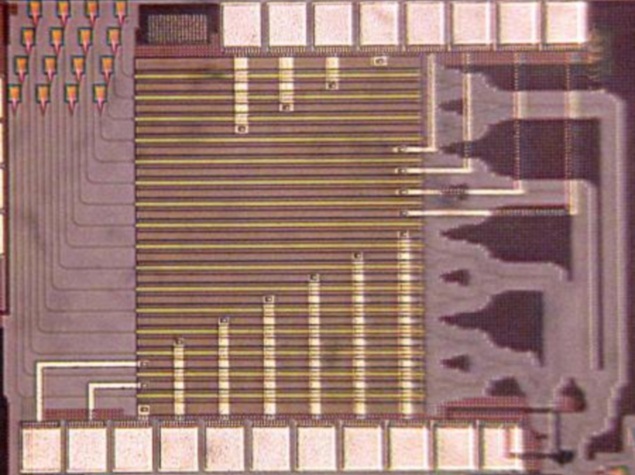- Home
- Mobiles
- Mobiles News
- New chip that turns cellphones into lens less projectors
New chip that turns cellphones into lens-less projectors

A new light-bending silicon chip has been developed by researchers at the California Institute of Technology (CalTech) that acts as a lens-free projector and could one day end up in your cellphone.
The new chip eliminates the need for bulky and expensive lenses and bulbs as used in traditional projectors.
"This chip uses a so-called integrated optical phased array (OPA) to project the image electronically with only a single laser diode as light source and no mechanically moving parts," explained Ali Hajimiri, Thomas G. Myers professor of electrical engineering at Caltech.
The beauty of the new chip is that it is small, can be made at a very low cost and opens up lots of interesting possibilities.
Hajimiri and his team bypassed traditional optics by manipulating the coherence of light - a property that allows the researchers to 'bend' the light waves on the surface of the chip without lenses or the use of any mechanical movement.
"By changing the relative timing of the waves, you can change the direction of the light beam," Hajimiri added.
Using a series of pipes for the light - called phase shifters - the OPA chip slows down or speeds up the timing of the waves, thus controlling the direction of the light beam.
The timed light waves are then delivered to tiny array elements within a grid on the chip.
The light is then projected from each array in the grid, the individual array beams combining coherently in the air to form a single light beam and a spot on the screen.
As the electronic signal rapidly steers the beam left, right, up, and down, the light acts as a very fast pen, drawing an image made of light on the projection surface.
"The new thing about our work is really that we can do this on a tiny, one-millimetre-square silicon chip. We can do it very rapidly to form images since we phase-shift electronically in two dimensions," said Behrooz Abiri, a graduate student in Hajimiri's team.
"In the future, this can be incorporated into a cellphone. Since there is no need for a lens, you can have a phone that acts as a projector all by itself," Hajimiri told the gathering at the Optical Fiber Communication (OFC) conference in San Francisco recently.
Catch the latest from the Consumer Electronics Show on Gadgets 360, at our CES 2026 hub.
Related Stories
- Samsung Galaxy Unpacked 2025
- ChatGPT
- Redmi Note 14 Pro+
- iPhone 16
- Apple Vision Pro
- Oneplus 12
- OnePlus Nord CE 3 Lite 5G
- iPhone 13
- Xiaomi 14 Pro
- Oppo Find N3
- Tecno Spark Go (2023)
- Realme V30
- Best Phones Under 25000
- Samsung Galaxy S24 Series
- Cryptocurrency
- iQoo 12
- Samsung Galaxy S24 Ultra
- Giottus
- Samsung Galaxy Z Flip 5
- Apple 'Scary Fast'
- Housefull 5
- GoPro Hero 12 Black Review
- Invincible Season 2
- JioGlass
- HD Ready TV
- Laptop Under 50000
- Smartwatch Under 10000
- Latest Mobile Phones
- Compare Phones
- Red Magic 11 Air
- Honor Magic 8 RSR Porsche Design
- Honor Magic 8 Pro Air
- Infinix Note Edge
- Lava Blaze Duo 3
- Tecno Spark Go 3
- iQOO Z11 Turbo
- OPPO A6c
- Lenovo Yoga Slim 7x (2025)
- Lenovo Yoga Slim 7a
- Lenovo Idea Tab Plus
- Realme Pad 3
- Moto Watch
- Garmin Quatix 8 Pro
- Haier H5E Series
- Acerpure Nitro Z Series 100-inch QLED TV
- Asus ROG Ally
- Nintendo Switch Lite
- Haier 1.6 Ton 5 Star Inverter Split AC (HSU19G-MZAID5BN-INV)
- Haier 1.6 Ton 5 Star Inverter Split AC (HSU19G-MZAIM5BN-INV)




![[Sponsored] Haier C90 OLED TV | Dolby Vision IQ, 144Hz OLED and Google TV in Action](https://www.gadgets360.com/static/mobile/images/spacer.png)









